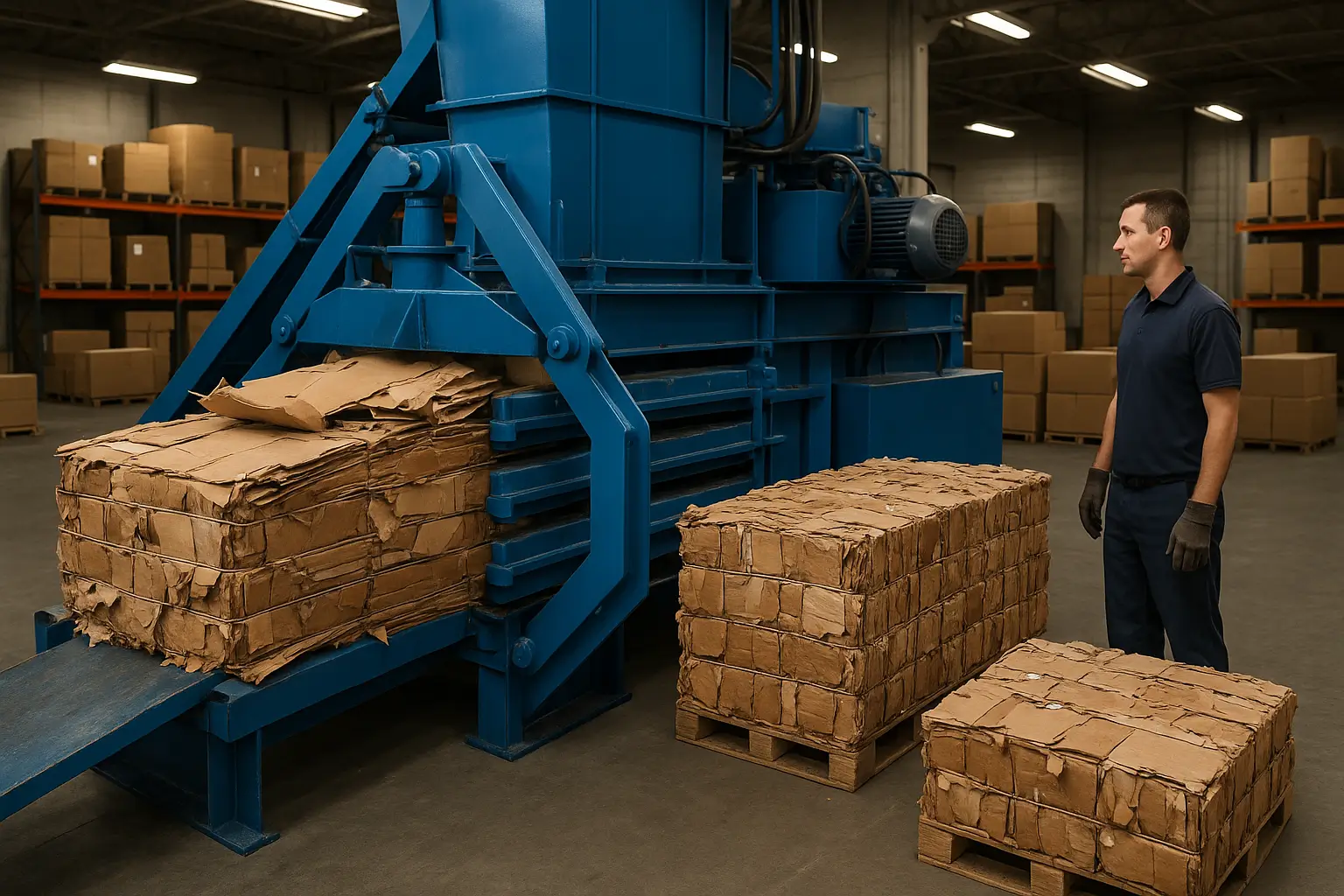Key Takeaway: Cardboard baling is a critical step in the recycling chain that transforms loose cardboard into dense, transport-efficient bales. Leasing a baler typically ranges from $200 to $600 per month. Effectively describing baling experience on a resume can highlight operational skills, equipment maintenance, and environmental stewardship. While Jet Equipment does not manufacture cardboard balers, specialist vendors such as Bramidan, Kernic Systems, and Ken Mills Engineering supply a range of vertical, horizontal, and twin-ram balers with bale weights from 250 lbs to over 1,400 lbs.
1. The Fate of Cardboard Bales
Once cardboard is compacted into bales, it embarks on a multi-stage journey through the recycling process:
- Collection and Transport Baled cardboard is loaded onto trucks or trailers and hauled to a recycling facility or paper mill. Owing to bale density—often exceeding 800 kg (1,760 lbs) per bale—transport costs are significantly reduced.
- Pulping and Fiber Separation At the paper mill, bales are fed into a pulper—essentially a large, high-speed blender—where water and agitation break the cardboard into individual fibers. Contaminants such as staples, tape, and inks are removed via screening, flotation, and centrifuging.
- De-inking and Cleaning The pulp undergoes chemical treatments to strip residual inks and adhesives. Air bubbles lift inks to the surface (flotation), while fine meshes filter out non-fiber debris.
- Refining and Blending Cleaned fibers are refined to improve bonding properties, then mixed with virgin pulp if necessary to achieve desired strength and quality.
- Sheet Formation and Drying The pulp slurry is spread onto moving screens to drain water, forming wet fiber mats. These are pressed and dried between heated rollers into continuous sheets of recycled paperboard.
- Conversion to Products The new paperboard is slit, cut, and corrugated to produce fresh cardboard packaging, completing the circular loop.
Environmental Impact:
- Reduces virgin fiber demand
- Cuts landfill volume
- Lowers greenhouse gas emissions (by avoiding methane from landfilled cardboard)
- Conserves water and energy compared to virgin paper production
2. Leasing a Cardboard Baler: Costs and Considerations
Leasing rather than purchasing spreads capital expenditure and ensures access to maintenance, repairs, and upgrades. Typical monthly lease ranges:
| Leasing Option | Monthly Cost |
|---|---|
| Small Vertical Baler (30–60 kg bales) | $200–$350 |
| Mill-Size Vertical Baler (200–500 kg bales) | $350–$600 |
| Semi-Automatic Horizontal Baler (250–700 kg bales) | $500–$900 |
Factors influencing lease rates include:
- Bale Capacity & Size: Larger bales require more robust machines with higher press forces.
- Automation Level: Manual-tie balers cost less than auto-tie or fully automatic models.
- Contract Length & Service Inclusions: Multi-year leases with full maintenance coverage yield lower monthly rates.
Example: GreenCo Recycling advertises vertical baler rent at $245/month with no long-term contract and all repairs covered. This includes periodic service visits and bale pickups if bundled with recycling service.
3. Crafting “Cardboard Bale” Experience on Your Resume
To highlight cardboard baling skills on a resume, focus on measurable achievements, operational expertise, and collaboration:
- Job Title: Material Handling Technician – Cardboard Baler Operator
- Key Responsibilities: – Operated [Model] vertical baler to compress up to 1,100 lbs of OCC per bale, producing 30+ bales/day. – Conducted daily inspection and preventive maintenance: hydraulic fluid checks, tie-strap replacement, safety-interlock testing. – Coordinated with recycling vendor to optimize pickup schedules, reducing waste storage footprint by 50%. – Trained 5 new team members on safe machine operation, emergency shutdown procedures, and bale-tie techniques.
- Achievements: – Improved bale density by 15% through feed-chamber optimization, increasing rebate revenue by $1,200/month. – Reduced downtime by 20% by implementing a standardized cleaning regimen for feed hoppers.
Use action verbs (operated, maintained, coordinated), quantify output (weights, counts, cost savings), and emphasize safety and environmental benefits.
4. Bale Weights: Cardboard vs. Clothing vs. Shrink Wrap
Different materials yield different bale weights based on density and baler capacity:
| Material | Typical Bale Weight |
|---|---|
| Cardboard (OCC) – Vertical Baler | 200–600 kg (440–1,320 lbs) |
| Cardboard (OCC) – Large Vertical (72×42″) | 1,400+ lbs |
| Horizontal Cardboard Baler | 500–1,500 kg (1,100–3,300 lbs) |
| Used Clothing (Textile) | 150–400 kg (330–880 lbs) |
| Shrink Wrap/LDPE | 300–800 lbs |
- Kernic Systems’ B5W Vertical Baler: – Cardboard bale: ~650 lbs – Shrink wrap bale: ~775 lbs
- Ken Mills Aries Twin Ram Baler: – Cardboard bale: up to 600 kg (1,322 lbs)
- Bramidan B7242 SD (Sliding Door): – Cardboard bale: 1,400+ lbs
5. Jet Equipment and Cardboard Balers
Jet Equipment, known for woodworking and metalworking machinery, does not produce dedicated cardboard balers. Instead, leading suppliers include:
- Bramidan (vertical & horizontal, smart-connected via BRA-IN)
- Kernic Systems/Bramidan Group (plug-and-play B5W series)
- Ken Mills Engineering (Aries twin-ram fully automatic)
- Industry Rentals (GreenCo, Landfill Alternatives, etc.)
6. Compression Capacity of Kenneth (Ken Mills) Balers
Ken Mills Engineering’s Aries Twin Ram Baler specifications:
- Press Force: 70 tonnes or 115 tonnes pressing force
- Cardboard Bale Weight: up to 600 kg (1,322 lbs)
- Bale Density: High-density output for mill-sized bales
- Throughput: Up to 20 bales/hour
This model excels in high-volume, continuous applications such as material recovery facilities and large distribution centers.
Conclusion and Recommendations
Cardboard baling is a transformative process that enhances recycling efficiency, reduces costs, and underscores corporate sustainability commitments. For companies handling moderate volumes, leasing a vertical baler at $200–$600/month provides flexibility and operational support without large capital outlay. When detailing baling roles on resumes, emphasize quantifiable metrics, maintenance proficiency, and environmental impacts. Although Jet Equipment does not offer balers, reputable manufacturers such as Bramidan, Kernic Systems, and Ken Mills Engineering deliver reliable solutions with bale capacities spanning from a few hundred pounds to over 1,400 lbs. Selecting the right baler involves balancing bale size, automation features, lease terms, and facility space to maximize ROI and streamline waste management.



Leave a Reply